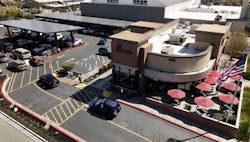If you’ve been to a Chick-fil-A during the lunch or dinner rush, you know the company’s approach to managing drive-thru traffic is the fast-food equivalent of a NASCAR pit stop. Cars are moved through at a pace that is likely both the envy of the competition and a key contributor to the chain's growing market share.
Thanks to a new microgrid, a Santa Rosa, California, Chick-fil-A will be able to keep dishing out chicken sandwiches and waffle fries at its expected pace, even if there is a grid outage.
Located on Mendocino Avenue, this is the second Chick-fil-A location in the state to be powered in part by a solar microgrid. The system includes a 150-kW solar canopy, a 150-kW natural gas genset and a 36-kWh lithium ion battery energy storage system.
A similar system was commissioned at a Chick-fil-A in Stockton, California, in 2022, marking one of the first instances of a quick-service restaurant (QSR) microgrid in the country.
The microgrid enables the restaurant to meet its sustainability goals and positively impact the community, as well as ensure business continuity and profitability, according to Kirk Edelman, CEO of SolMicroGrid, the Georgia-based solar microgrid system developer that built the project.
SolMicroGrid owns and operates both the Santa Rosa and Stockton systems under an energy-as-a-service (EaaS) agreement with the Atlanta-based quick-service restaurant chain.
EaaS agreements eliminate the need for customers to invest upfront capital. The developer typically retains ownership of the microgrid and its components, operating and maintaining the system for the duration of the agreement. The developer sells the energy generated by the system to the host at a reduced rate.
Chicken, with a side of energy resilience
The grid-connected microgrid can net meter power back to Pacific Gas & Electric (PG&E) but also provides the quick-service restaurant with energy resiliency, allowing it to continue to serve the community even when there is a grid outage.
In Stockton, the solar microgrid provides a significant portion of the QSR’s daily power needs, helping local owners meet corporate sustainability goals. Additionally, because the EaaS agreement sets energy costs below those available from PG&E, the restaurant’s energy bills are reduced.
Resiliency is provided by the on-site natural gas genset, which can be used to meet the restaurant’s full power needs in the case of a grid outage.
Quick service delivered sustainably
Founded in 1967, Chick-fil-A has more than 3,000 independently owned and operated quick-service restaurants in the U.S., Canada and Puerto Rico.
“Chick-fil-A embraces opportunities for environmental stewardship, and this innovative microgrid system allows us to both care for our planet and local communities,” said Heather Beaubien, director of sustainability for Chick-fil-A. “Harnessing this unique energy strategy at Chick-fil-A Mendocino Avenue helps the restaurant reduce its reliance on the local utility grid and continue operating to serve the community in times of need.”
Chick-fil-A and SolMicroGrid plan to launch a third microgrid in California later this year.








